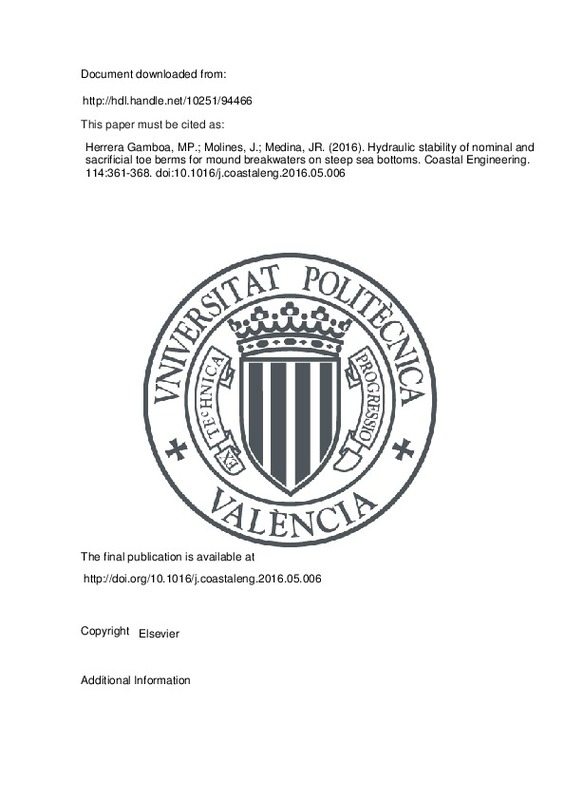JavaScript is disabled for your browser. Some features of this site may not work without it.
Buscar en RiuNet
Listar
Mi cuenta
Estadísticas
Ayuda RiuNet
Admin. UPV
Hydraulic stability of nominal and sacrificial toe berms for mound breakwaters on steep sea bottoms
Mostrar el registro sencillo del ítem
Ficheros en el ítem
| dc.contributor.author | Herrera Gamboa, María Piedad
|
es_ES |
| dc.contributor.author | Molines, Jorge
|
es_ES |
| dc.contributor.author | Medina, Josep R.
|
es_ES |
| dc.date.accessioned | 2018-01-11T09:47:33Z | |
| dc.date.available | 2018-01-11T09:47:33Z | |
| dc.date.issued | 2016 | es_ES |
| dc.identifier.issn | 0378-3839 | es_ES |
| dc.identifier.uri | http://hdl.handle.net/10251/94466 | |
| dc.description.abstract | [EN] When mound breakwaters are placed on steep sea bottoms in combination with very shallow waters, the design of the toe berm becomes a relevant issue. Toe berms built close to the water surface on a steep sea bottom must withstand such high wave loads that their design may not be feasible with available quarrystones. In this study, a new design method was developed to reduce the rock size by increasing the toe berm width. The analysis involved specific 2D small-scale tests with toe berms of different rock sizes and widths, placed on a m = 1/10 bottom slope with the water surface close to the toe berm crest. Two new concepts were introduced to better characterize damage to wide toe berms: (1) the most shoreward toe berm area which effectively supports the armor layer, in this study referred to as the primary or nominal toe berm and (2) the most seaward toe berm area which serves to protect the nominal toe berm, in this study called the secondary or the sacrificial toe berm. Damage to the nominal toe berm was used to describe hydraulic stability of wider toe berms. Given a standard toe berm of three rocks wide (nominal toe berm), an equivalent toe berm with damage similar to the nominal toe berm was defined by increasing the berm width and decreasing the rock size. The reduction in rock size showed an inverse 0.4-power relation with the relative berm width. | es_ES |
| dc.language | Inglés | es_ES |
| dc.publisher | Elsevier | es_ES |
| dc.relation.ispartof | Coastal Engineering | es_ES |
| dc.rights | Reconocimiento - No comercial - Sin obra derivada (by-nc-nd) | es_ES |
| dc.subject | Hydraulic stability | es_ES |
| dc.subject | Mound breakwater | es_ES |
| dc.subject | Nominal toe berm | es_ES |
| dc.subject | Sacrificial toe berm | es_ES |
| dc.subject | Shallow water | es_ES |
| dc.subject | Steep sea bottom | es_ES |
| dc.subject | Toe berm | es_ES |
| dc.subject.classification | INGENIERIA E INFRAESTRUCTURA DE LOS TRANSPORTES | es_ES |
| dc.title | Hydraulic stability of nominal and sacrificial toe berms for mound breakwaters on steep sea bottoms | es_ES |
| dc.type | Artículo | es_ES |
| dc.identifier.doi | 10.1016/j.coastaleng.2016.05.006 | es_ES |
| dc.relation.projectID | info:eu-repo/grantAgreement/MINECO//BIA2012-33967/ES/ESTABILIDAD HIDRAULICA DE LOS MANTOS DE ESCOLLERA, CUBOS Y CUBIPODOS FRENTE A OLEAJE LIMITADO POR EL FONDO/ | es_ES |
| dc.rights.accessRights | Abierto | es_ES |
| dc.date.embargoEndDate | 2018-08-31 | es_ES |
| dc.contributor.affiliation | Universitat Politècnica de València. Departamento de Ingeniería e Infraestructura de los Transportes - Departament d'Enginyeria i Infraestructura dels Transports | es_ES |
| dc.description.bibliographicCitation | Herrera Gamboa, MP.; Molines, J.; Medina, JR. (2016). Hydraulic stability of nominal and sacrificial toe berms for mound breakwaters on steep sea bottoms. Coastal Engineering. 114:361-368. https://doi.org/10.1016/j.coastaleng.2016.05.006 | es_ES |
| dc.description.accrualMethod | S | es_ES |
| dc.relation.publisherversion | http://doi.org/10.1016/j.coastaleng.2016.05.006 | es_ES |
| dc.description.upvformatpinicio | 361 | es_ES |
| dc.description.upvformatpfin | 368 | es_ES |
| dc.type.version | info:eu-repo/semantics/publishedVersion | es_ES |
| dc.description.volume | 114 | es_ES |
| dc.relation.pasarela | S\322302 | es_ES |
| dc.contributor.funder | Ministerio de Economía y Competitividad | es_ES |







![[Cerrado]](/themes/UPV/images/candado.png)

